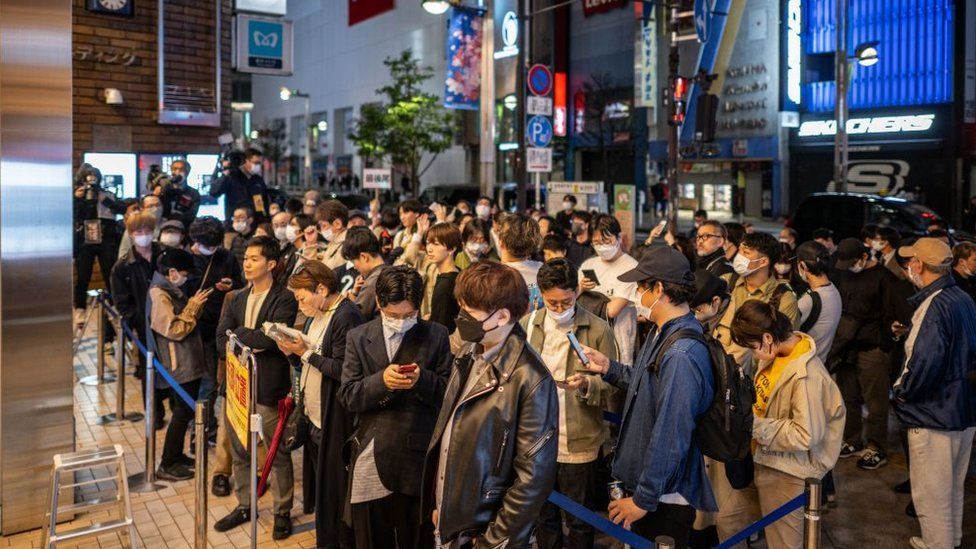
Throngs of fans joined late night queues outside bookstores across Japan last week, eager to lay their hands on Haruki Murakami’s new novel – his first in six years.
At one Tokyo bookstore, which hung a two-storey LED banner counting down the time to release, copies of The City And Its Uncertain Walls were snapped up at midnight.
Many readers dived straight in upon getting their copy. Pictures online showed readers curled up in all-night cafes, with cups of coffee by their side.
The new novel, which the 74-year-old wrote in isolation during the pandemic, follows the protagonist’s journey into a city surrounded by high walls. The 661-page read is divided into three parts, in which the protagonist moves from his teenage years into middle age.
But plot is perhaps the least important element in Murakami’s novels which are known for their meandering magical-realist storylines.
For many readers, the plot points are merely jumping-off points for explorations of loss, isolation, identity and increasingly, social and political events.
The latest book was written during the pandemic.
“I started writing this novel in early March 2020, when the coronavirus started raging in Japan, and it took me almost three years to finish,” Murakami said in the book’s statement issued by his publisher Shinchosha.
He hardly went out or took long trips during those years, he said.
“In this quite extraordinary, tense environment, I diligently wrote this piece, as if a ‘dreamreader’ reads ‘old dreams’ in a library,” he added.
It is that kind of enigmatic line that sends his legion of fans around the world into frenzy. In anticipation of the book’s release, a bookstore in Nagoya city put up a capsule machine dispensing sentences from his novels.
‘You’re drawn in’
Six years isn’t the longest time between books, and Murakami has been prolific over a four-decade career. He’s produced at least 14 novels and several short-story collections with works translated into more than 50 languages.
But the overwhelming reception to his latest book reflects his enduring popularity, particularly in his homeland.
One longtime Murakami reader, Yu, told the BBC the appeal of his works is how he connects the “two worlds” of dreams and reality.
“Sometimes they are ‘me’ and sometimes they are ‘not me’, and that creates a sense of absorption. For me, his novels are like warm and soft mud. You get comfortably drawn and absorbed into these stories,” she said.
The 36-year-old read the entirety of the new book in one sitting on Thursday, the day after it was released. She attacked it with the same enthusiasm as when she first picked up a Murakami work more than 20 years ago, at the recommendation of her primary school teacher.
The BBC is not responsible for the content of external sites.
Allow Twitter content?
This article contains content provided by Twitter. We ask for your permission before anything is loaded, as they may be using cookies and other technologies. You may want to read Twitter’s cookie policy and privacy policy before accepting. To view this content choose ‘accept and continue’.
The BBC is not responsible for the content of external sites.

Part of the joy of picking up a Murakami book is sinking into a world of established motifs, readers have said.
Murakami tropes are so well known they even inspired a bingo cartoon, published in the NY Times’ Sunday Book Review in 2014. Murakami bingo includes an “ear fetish, a “mysterious woman” or “faceless villain”, “urban ennui”, “Tokyo at night” and various supernatural spookiness and things vanishing.
“I think Murakami’s worlds sit so well with many people across the world because he is beyond culture in a way,” said Gitte Marianne Hansen, a lecturer in Japanese Studies at Newcastle University.
“His stories speak to the core of humanity in our inner modern lives and this is what we respond to as readers. The core feeling of loneliness and alienation is probably beyond culture,” said Dr Hansen, who has translated Mr Murakami’s short stories.
However, the author has been increasingly criticised for his portrayal of women.
Critics say female characters in Mr Murakami’s books are often sexualised or defined only in relation to the male protagonists.
Mr Murakami himself said in a 2004 interview with The Paris Review: “If the sex is good… Your injury will be healed, your imagination will be invigorated… In that sense, in my stories, women are mediums – harbingers of the coming world. That’s why they always come to my protagonist; he doesn’t go to them.”
This is simply “the male voice that [Mr Murakami] privileges”, says Michael Tsang, a Japanese Studies lecturer at Birkbeck, University of London. His dominance illustrates that Japan “needs to do more about gender and other minority groups.”

But for some, the misogyny in Mr Murakami’s works is hard to overlook, and that could be one reason as to why literature’s biggest honour has eluded him for so many years.
“Hello Japan’s pundits, Haruki Murakami will not get a Nobel prize unless he gets rid of all his misogyny… Pin your hopes on a better Japanese writer,” one Twitter user argued.
“The sexualisation of an underage girl, as well as detailed descriptions of the voluptuousness of her body, can be considered problematic per today’s literary context,” said Koichiro Sukegawa, a Japanese literature professor at Gifu Women’s University.
The new book is a radical rewrite of his novella of the same name, first published in a magazine in 1980. The author said he believed more could be mined from the material.
Mr Murakami’s writing has always been seen to offer a “cool, Japanese culture that is exported to the rest of the world, said Dr Hansen.
Much of his work can be read against the backdrop of the Japanese economic recessions in the 1980s and 1990s. But it doesn’t preclude readers from other cultures from understanding him.
“In fact, it is remarkable that his work can reach such a wide readership despite being set mostly in Japan and speaking to a very ‘Japanese’ social fabric,” said Dr Tsang.
His short story Sleep, published in 1993 about a housewife who struggles to go to bed at night, was viewed as a response to Japanese family and gender norms.
He has also written and spoken about the nuclear disasters and earthquakes that have ravaged Japan.
Mr Murakami’s works have also inspired other forms of art. The Oscar-winning film Japanese film Drive My Car was based on several of the author’s short stories, including one of the same title.
His latest book has flown off the shelves. Shinchosha announced an initial print run of 300,000 copies and had sold more than half by the end of the first week. On Wednesday they announced a second re-print.
Two volumes of his previous novel Killing Commendatore, published in February 2017, saw 700,000 and 600,000 orders respectively.
An English translation of Mr Murakami’s newest title will be made available later this year.
Related Topics
-
-
25 November 2020
-
-
-
17 October 2011
.jpg)
-

